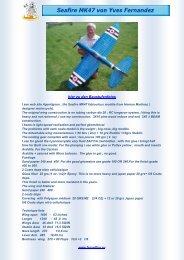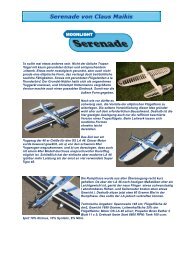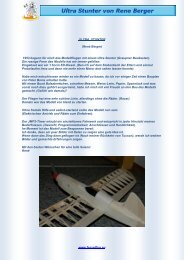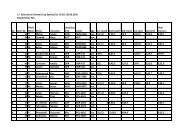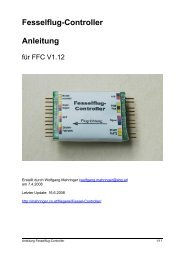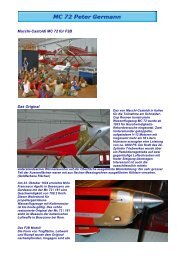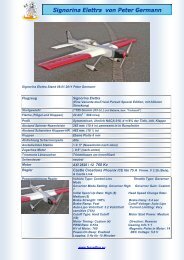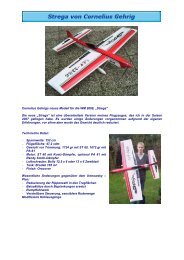Download this Article as PDF-File
Download this Article as PDF-File
Download this Article as PDF-File
Create successful ePaper yourself
Turn your PDF publications into a flip-book with our unique Google optimized e-Paper software.
Fig 4.<br />
Let’s go to the Tab labeled “Motor”. “Motor Start Up power” not a real critical item - medium is a good staring<br />
point. Do be careful that it is not too low, <strong>as</strong> problems with power on takeoff will manifest themselves. You<br />
should be at full power at 12-15 feet after start of role. This function also interrelates with “Initial Spool-up<br />
Rate”.<br />
“Motor Timing” The ICE controller uses an advanced timing method where the timing is adjusted automatically<br />
b<strong>as</strong>ed on load and RPM. The way the principle designer (Patrick del C<strong>as</strong>tillo) suggests setting our timing is… “I'd<br />
suggest you bump the timing up slightly from "low" (using custom setting) until you get the power you want.<br />
The lower timing will give you a much more efficient and cooler running system (less wear and tear on the<br />
motor too!)”<br />
What you see is my end result; I went from Custom (2) and stepped up incrementally to Custom (4). “Medium<br />
(5)” equates to approximately 18 deg from ZCO (EMF crossing zero). I have heard the guys in the Czech Republic<br />
recommend 12 deg so a setting of 2-4 is somewhere in the right area.<br />
“Direction” <strong>this</strong> is self explanatory.<br />
“PWM Rate” set to 8 KHz but others have used 12 KHz successfully. 8 KHz is the most efficient settings for a<br />
medium size outrunner. The general rule is the lower the motor’s inductivity, the higher the switching<br />
frequency should be. Incre<strong>as</strong>ing the switching frequency reduces the ripple in the current flow in part-load<br />
mode; but at the same time causes a rise in eddy current losses in the motor and switching losses in the<br />
controller. These losses do create heat in both the motor and the ESC. So if you run a higher PWM frequency<br />
expect to spend a little more current and generate a little more heat. As rule of thumb for selecting PWM for<br />
the motor - try <strong>this</strong> formula – Motor Kv x Magnetic Pole Count of the Motor x Nominal Volts used then divide by<br />
a factor of 20. Then round the answer down to the nearest setting on the ESC PWM Rate.<br />
1) Motor Kv 760 x Magnetic Pole Count 14 = (760 x 14 = 10,640 )<br />
2) Times Nominal Volts 18.5 vDC = (10,640 x 18.5 =196,840)<br />
3) Then divide by a factor of 20 = (196840/20 =9842)<br />
4) Round down 9842 = 8000 or 8K



